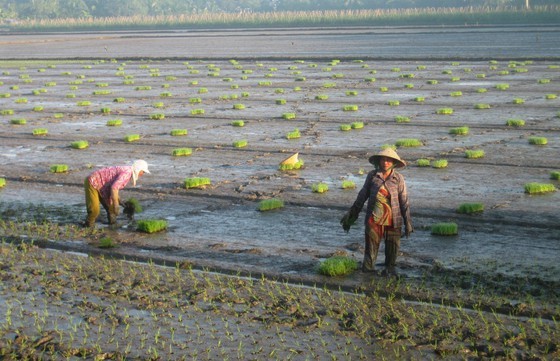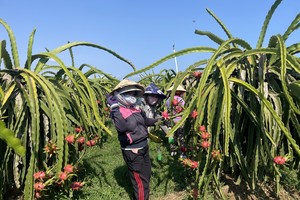
From November 20 to 30, districts need to speed up growing of the second stage of winter-spring rice crop in order to deal with early saltwater intrusion.
It is worrisome that besides 1,800 hectares of winter-spring rice being infected with rice blast disease, rice bacterial blight and rice leaf-roller, there are around 318 hectares of rice in An Bien and An Minh districts affected by saltwater as farmers grew rice on shrimp-farming areas which have not been desalinated well.
The Department of Irrigation of Kien Giang Province said that it is forecast that saltwater intrusion will come early and threaten agricultural production, especially the winter-spring rice crop. Therefore, the irrigation department has been closing sluice gates in coastal areas, including Kien Luong, Hon Dat, Chau Thanh and Rach Gia City. These sluice gates are closed earlier than previous years. Besides, it will increase dredging irrigation system and store fresh water to serve production and daily life.
According to the Department of Crop Production, it is estimated that provinces in the Mekong Delta have sowed more than 600,000 hectares of winter-spring rice crop. At the present, Hau Giang, Dong Thap, Vinh Long, An Giang and Tra Vinh provinces also rush to grow rice in order to avoid saltwater intrusion.
According to the Directorate of Water Resources, as flood peak was low this year, saltwater intrusion is expected to be 1-2 months sooner than previous years.
It is forecast that salinity of 4 grams per liter will intrude inland by 20-30 kilometers from November to December this year and by 40-67 kilometer from January to February next year, about 15 kilometers higher than the average level of several years. This will affect greatly water intake capacity of irrigation works.
By March next year, depending on the amount of water adjusted from reservoirs at the upper reach of the Mekong River, if the amount of water increases as recent years, saltwater intrusion will recede; if the amount of water stays the same, saltwater intrusion will maintain at the same level as it will be in January and February next year.
Amid the situation that drought and saltwater intrusion develop complicatedly, the Ministry of Agriculture and Rural Development ordered Mekong Delta provinces to speed up the growing progress of winter-spring rice crop.
Particularly, by the end of November, farmers will finish growing around 1.2 million hectares of winter-spring rice out of a total area of more than 1.55 million hectares. The rest area is expected to finish in December this year.
The Ministry of Agriculture and Rural Development recommended that farmers should use saline-tolerant, alkaline-tolerant and drought-tolerant rice varieties at areas where saltwater and drought might affect at the end of the crop in order to avoid possible losses.
Growing rice early and flexibly in areas affected by saltwater intrusion at coastal provinces will ensure enough water for rice production. In addition, it will help to prevent local drought at some places in the alluvial freshwater delta.
It is worrisome that besides 1,800 hectares of winter-spring rice being infected with rice blast disease, rice bacterial blight and rice leaf-roller, there are around 318 hectares of rice in An Bien and An Minh districts affected by saltwater as farmers grew rice on shrimp-farming areas which have not been desalinated well.
The Department of Irrigation of Kien Giang Province said that it is forecast that saltwater intrusion will come early and threaten agricultural production, especially the winter-spring rice crop. Therefore, the irrigation department has been closing sluice gates in coastal areas, including Kien Luong, Hon Dat, Chau Thanh and Rach Gia City. These sluice gates are closed earlier than previous years. Besides, it will increase dredging irrigation system and store fresh water to serve production and daily life.
According to the Department of Crop Production, it is estimated that provinces in the Mekong Delta have sowed more than 600,000 hectares of winter-spring rice crop. At the present, Hau Giang, Dong Thap, Vinh Long, An Giang and Tra Vinh provinces also rush to grow rice in order to avoid saltwater intrusion.
According to the Directorate of Water Resources, as flood peak was low this year, saltwater intrusion is expected to be 1-2 months sooner than previous years.
It is forecast that salinity of 4 grams per liter will intrude inland by 20-30 kilometers from November to December this year and by 40-67 kilometer from January to February next year, about 15 kilometers higher than the average level of several years. This will affect greatly water intake capacity of irrigation works.
By March next year, depending on the amount of water adjusted from reservoirs at the upper reach of the Mekong River, if the amount of water increases as recent years, saltwater intrusion will recede; if the amount of water stays the same, saltwater intrusion will maintain at the same level as it will be in January and February next year.
Amid the situation that drought and saltwater intrusion develop complicatedly, the Ministry of Agriculture and Rural Development ordered Mekong Delta provinces to speed up the growing progress of winter-spring rice crop.
Particularly, by the end of November, farmers will finish growing around 1.2 million hectares of winter-spring rice out of a total area of more than 1.55 million hectares. The rest area is expected to finish in December this year.
The Ministry of Agriculture and Rural Development recommended that farmers should use saline-tolerant, alkaline-tolerant and drought-tolerant rice varieties at areas where saltwater and drought might affect at the end of the crop in order to avoid possible losses.
Growing rice early and flexibly in areas affected by saltwater intrusion at coastal provinces will ensure enough water for rice production. In addition, it will help to prevent local drought at some places in the alluvial freshwater delta.
























